

Easy Report Writer by grahamcolman - UK Teaching Resources - TES. Introduction to Evaluation. « PreviousHomeNext » Evaluation is a methodological area that is closely related to, but distinguishable from more traditional social research.
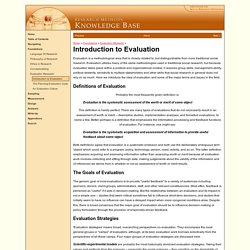
Evaluation utilizes many of the same methodologies used in traditional social research, but because evaluation takes place within a political and organizational context, it requires group skills, management ability, political dexterity, sensitivity to multiple stakeholders and other skills that social research in general does not rely on as much. Here we introduce the idea of evaluation and some of the major terms and issues in the field.
Definitions of Evaluation Probably the most frequently given definition is: Evaluation is the systematic assessment of the worth or merit of some object This definition is hardly perfect. Studying_your_visitors_where_to_begin. 5074_Alkin_Chapter_2. The CIPP evaluation model. The CIPP model of evaluation Basically, the CIPP model requires that a series of questions be asked about the four different elements of the model.
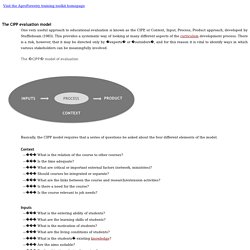
Context — What is the relation of the course to other courses? — Is the time adequate? — What are critical or important external factors (network, ministries)? — Should courses be integrated or separate? — What are the links between the course and research/extension activities? — Is there a need for the course? Rubrics for Evaluating Educational Apps.
How do you choose the best educational app for your classroom?
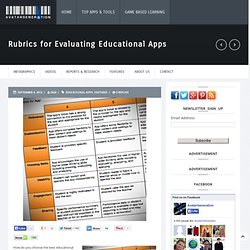
Check out this great post from Tony Vincent on LearningHand, sharing his own rubric to help teachers evaluate educational apps and other rubric resources. Spotlighted in the Rubric are: RelevanceThe app’s focus has a strong connection to the purpose for the app and appropriate for the studentCustomizationApp offers complete flexibility to alter content and settings to meet student needsFeedbackStudent is provided specific feedbackThinking SkillsApp encourages the use of higher order thinking skills including creating, evaluating, and analyzingEngagementStudent is highly motivated to use the appSharingSpecific performance summary or student product is saved in app and can be exported to the teacher or for an audience Download Resources: apps, Rubric. Teaher's Guide to Information Crap Detection.
Information overload, information crap,information pollution...are some of the words that are being used now to describe the tsunami of irrelevant information we are bombarded with day and night.In December 2009, Google began customizing its search results for all users, and we entered a new era of personalization.

With little notice or fanfare, our online experience is changing, as the websites we visit are increasingly tailoring themselves to us.Everywhere you turn you find information that seems relevant to you but in fact is nothing but crap. This is probably why Eli Pariser recommended what he called Information Bubble. Howard Rheingold is another guy who has done a lot of writings on Information Crap. I have already reviewed his awesome book Net Smart: How to Thrive Online in an article posted last year. 2- Internet Detective This is another great resource full of lessons, tutorials on how to teach your students to be good consumers of online information. 4- Crap Test 5- Video.
Online Training Evaluation Tool - TrainingCheck. StarQuiz. Quickly Create Online Quizzes For Free. Seven stages of writing assignments. Evaluations : Commission Guidance Documents. Evaluating EU cohesion policy Guidance Documents for the 2014 – 2020 funding period Impact evaluation centre In any programme, the crucial questions are "what do you want to change?
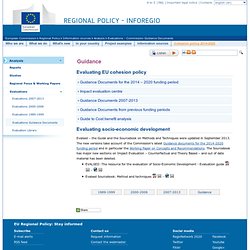
" and "how would you know if you have changed it? " These evaluation questions are not just bureaucratic requirements, but the essence of good programming. Impact evaluation in DG Regional Policy falls into two broad categories: The "Theory-based" impact approach, which follows each step of the intervention logic and focuses on the mechanisms leading to the observed change, is particularly appropriate for answering the questions "why? " The two approaches are complementary and the most useful impact evaluations draw on a mix of methods: counterfactual methods to quantitatively estimate an impact, theory-based methods to understand the underlying mechanisms and the context of an intervention thus helping to modify or generalize it to other contexts. Conterfactual approach Theory-based approach. Evaluation Toolkit. At NSTTAC, we are committed to data-based decision making and we view evaluation as a tool for improving our work.
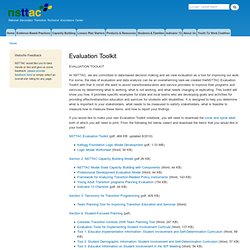
For some, the idea of evaluation and data analysis can be an overwhelming task-we created theNSTTAC Evaluation Toolkit with that in mind! We want to assist transitioneducators and service providers to improve their programs and services by determining what is working, what is not working, and what needs changing or replicating. This toolkit will show you how. It provides specific examples for state and local teams who are developing goals and activities for providing effectivetransition education and services for students with disabilities. It is designed to help you determine what is important to your stakeholders, what needs to be measured to satisfy stakeholders, what is feasible to measure,how to measure these items, and how to report your findings. NSTTAC Evaluation Toolkit (pdf, 469 KB: updated 8/2010) Section 2: NSTTAC Capacity Building Model (pdf 26 KB)